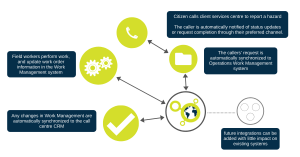When you picture a traditional government workflow, you envision busy hold times, vague or limited information and delayed response times. In government management systems you can have anywhere from 75 to 250 IT software systems supporting the business. These systems are often siloed by department, with the exchange of data or information happening through manual processes such as exported reports, point-to-point custom-coded integrations and rekeyed information in various systems. These disconnected systems do not enable step by step automation, which in turn, affects the overall process.
Here is an example of a traditional government workflow:
- Citizen calls client services center to report a hazard (perhaps a city tree needs a trim)
- Call service agent creates a case in the citizen request system
- Service agent emails the case details to operations
- Operations dispatcher manually creates a work order in the work management system
- Operations staff execute the work order, add comments and activities, and changes the work order status as the order makes its way through a process
The Problem: Lack of Transparency
Based on this workflow, the citizen who called in has an extreme lack of transparency on the status of their report. The citizen has no idea if the work has started, is in progress, or is complete. Many times a citizen will be informed that their case is closed, but will have no information on whether the work was actually completed – no follow up or follow through. Will this citizen bother to call again?
The Solution: Automating the Flow of Work
To enable transparency, it is necessary to automate the flow of work. Since the flow of work is controlled by systems that are siloed, the active exchange of information across systems is both necessary and vital. Enterprise Integration (EI) is the practice of enabling systems to communicate work, data, and information between each other. It leverages a series of design patterns in terms of how and what is communicated, and at what frequency (transactional in real-time, in batch or on a schedule). EI also attempts to loosen the connections between systems to enable simplified upgrades, lower-cost exchange, and elimination of custom-coded point-to-point data exchange.
Transparency here is about making the overall process open to query, particularly around status. Was any work created? What is the next step in the process that might be expected? When will the work be completed? This last question hits on one of the most contentious aspects regarding transparency – service level agreements.
Service Level Agreements:
A Service Level Agreement (SLA) is essentially an agreement between departments, per request type, which lays out the time for response to a request, the escalation process and the time periods to make sure each request is accounted for and processed. Without service level agreements, it is not possible to set expectations or provide any (valid) response to citizens, or their representatives.
Measuring Performance with SLA’s:
Once there is a set of expectations encapsulated in a Service Level Agreement, it is then possible to measure performance against expectations. Performance measurement requires well-defined processes for what happens to each type of work when it is received by operations, by-law, planning, or other departments. Performance measures capture the response times for work requests, the changing status of work from open to close, and the escalation of service level agreement violations. The SLA holds departments accountable to management, elected representatives, and citizens.
Performance information can thereby inform the local government for changes to the structure, business processes, consolidation of activities, selection of technology, and the automation of data exchange. This assists in clarifying roles, responsibilities, and efficient use of funds through all work processes.
The Benefits:
Transparent Workflow
With automated workflows, service requests are transferred to the right department with the right data in real-time. With integrated systems that freely exchange information in an automated way, your task will automatically be assigned, processed and updated throughout the scope of the project, and be visible to all viewing. With the ability to have a single view into a citizen’s profile and related work orders, call agents can file requests with ease and speed.
Improved Reporting
With integrated data silos in a workflow, you are able to meet performance indicators and automate reporting by ensuring all information trapped in data silos is integrated and available. With all data being shared seamlessly through systems, dashboards can be produced to show Key Performance Indicators (KPI) and measure success and customer satisfaction for future reporting and improvements.
Extendable & Future Proof
Engineering an efficient flow of information between citizens and operations for work requests, as well as reporting against KPIs and SLAs is often the first step for a local government. Once you start leveraging the same EI platform and design patterns, it is possible to start automating workflows and increasing the transparency for other municipal systems. This permits by-law enforcement, materials inventory, staff utilization for operations, and provisioning information to enter Big Data systems for predictive analysis.

Conclusion:
Transparency is a key service expected by citizens to have in their government. Spatial DNA offers a suite of enterprise integration technologies and services that enables transparency within a government to elected representatives, staff and citizens. We help automate the mundane, and often manual tasks, so that local government staff can creatively solve the real problems affecting citizens, businesses, visitors, infrastructure, and the environment.
Learn more about integrated workflow benefits with our Richmond Hill Case Study.
Contact Spatial DNA to learn how you can streamline your local government workflow: https://spatialdna.com/book-a-meeting/